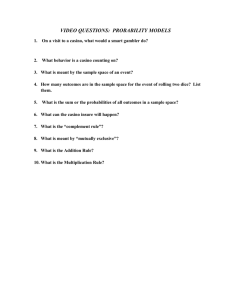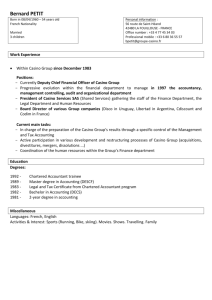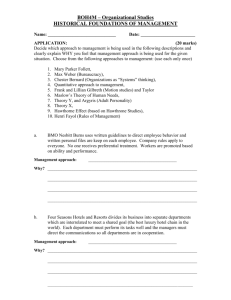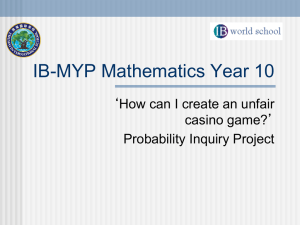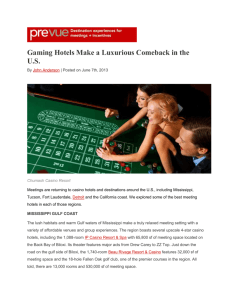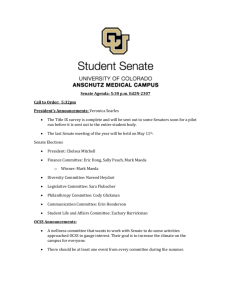SPMP Document - e
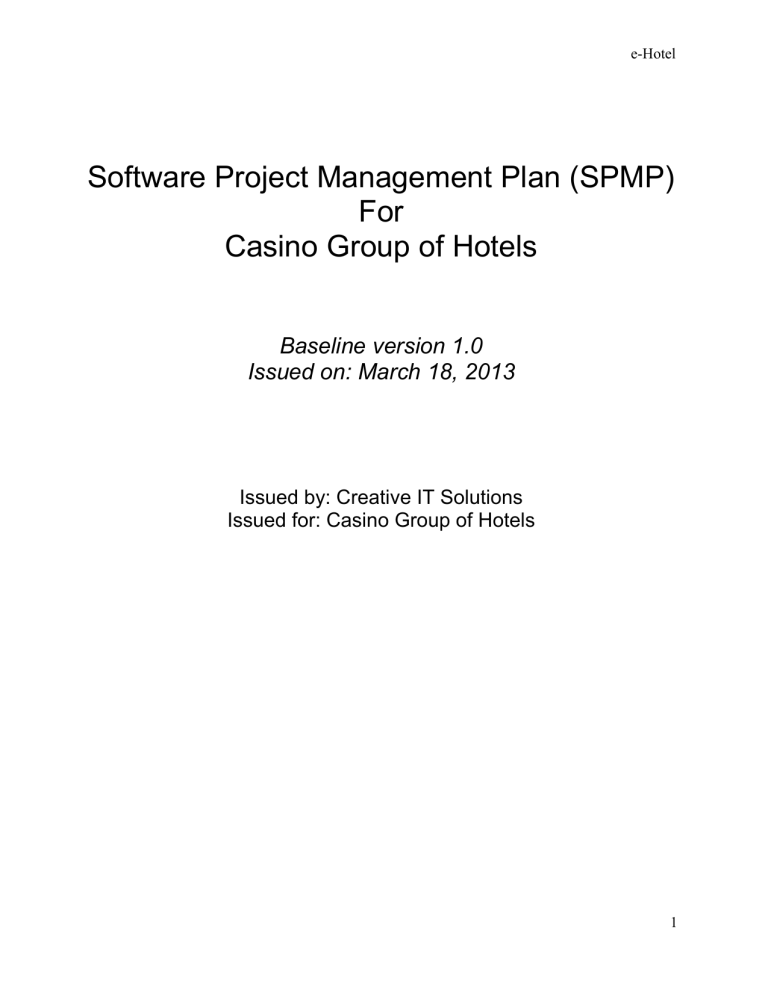
e-Hotel
Software Project Management Plan (SPMP)
For
Casino Group of Hotels
Baseline version 1.0
Issued on: March 18, 2013
Issued by: Creative IT Solutions
Issued for: Casino Group of Hotels
1
e-Hotel
Signature
The following signature indicates approval of the enclosed Software Project
Management Plan.
………………………………….Casino Group of Hotel’s representative.
2
e-Hotel
Change History
Version
1.0
Date
18 th March 2013
Author
Tharun Varghese
Changes
Initial Version
3
e-Hotel
Preface:
The SPMP (Software Project Management Plan) is created for the e-Hotel Project. The
Purpose of this document is to ensure that SWOT analysis have properly been done with respect to the cost and benefit analysis for the e-Hotel project. Creative IT
Solutions is a software development company, which is authorized to perform the analysis, design and implementation of the proposed E-Commerce Project for managing hotel room bookings, recreation and other similar activities. The Creative IT
Solutions will be responsible only for the development and delivery of the software application. The hardware and other resources which are required for the running of the software should be provided by the Casino Group of Hotels. This Software Project
Management Plan outlines a brief plan about the different stages, milestones and deliverables which are included in the project.
4
e-Hotel
Table of Contents
5
e-Hotel
6
e-Hotel
1.0. Overview:
This section of the document gives an introduction to Creative IT Solution’s proposal to complete the online hotel management system known as ‘e-Hotel’ for ‘Casino Group of
Hotels’. The document describes the scope and the objectives of the project that are to be fulfilled, the assumptions and constraints of the project, the project deliverables and a summary of the project schedule and budget.
1.1 Project Summary:
1.1.1. Purpose:
The purpose of th is project which is named as ‘e-Hotel’ is to develop an online Hotel
Management System that will assist the ‘Casino Group of Hotels’ in their daily hotel business. The main purpose of the project is to design a scalable and extensible system for managing the hotel activities. The system will be designed with the user-centric approach that will ensure that the user requirements mentioned in the documents must be full filled and must conforms to the required standards. The new proposed system will operate efficiently by eliminating all the time consuming issues and provides a better and much enhanced services to the customers as well as the management and staff of the
Casino Group of Hotels.
‘e-Hotel’ can be considered as a perfect software solution for hospitality industry since it contains all the modules which are necessary for all the aspects of the hotel industry. The proposed software is a multi-platform software such that it will work in all the operating systems and most of the browsers. This will help the customers to do business with the Casino Group of Hotels regardless of which Operating
System or which browsers they are using.
1.1.2. Scope:
The existing system is a manual system. We are planning to automate the current manual system. This will help the customers to do business with Casino Group of Hotels from anywhere in the world. The proposed system will cover the booking of rooms, meals, pick up services from the nearby railway station or airports and account details.
The additional facility information regarding the different services will be added in the web site.
The booking module is used to reserve the hotel rooms. The customer can book the rooms through online or through phone or in person. The customer needs to enter their personal details and have to pay 10 percentage of the total payment to confirm the booking. An email containing the confirmation details will be sent to the cus tomer’s email address. When the customer books the room through telephone or in person, the staff
7
e-Hotel members of the Casino Group of Hotels need to enter the customer details by logging to employee modules with corresponding authorization.
Al l the details of the employees are stored in the employee details module. The staffs are divided into two categories – one represents the management staffs and other represents the employees. Both of them will be giving separate access authorization. In the employee details module, we can add the employee details, modify or delete the employee details. Reports are sections which help the employees as well as the management staffs to evaluate the hotel business. This will help the Casino Group of
Hotels to verify how many customers were there in last month, how much profit that they earned etc.We are developing the feedback section which helps the hotel management to improve their standards. The customers are able to send feedbacks as emails to
Casino Group of Hotels. The customer representative from the Casino Group of Hotels will evaluate the feedbacks and can take proper actions on them. The billing facilities are also included in the scope of this project.
The training will not be covered by the Creative IT Solutions. Instead a user manual will be provided which will help the Casino staff to use the system.
1.1.3. Objectives of the proposed system:
1) To enable online booking of rooms and other facilities such as pick-up from airport or railway station etc.
2) To enable automated customer data entry methods.
3) Automated confirmation emails will be sending to the customer upon successful booking.
4) To ensure efficient communication between the customers and the hotel management.
5) To enable easy modification and deletion of customer as well as employee details.
6) To enable enhanced security mechanism to prevent the customer details.
7) Enable fast and quick retrieval of the customer data.
8) The proposed system will be more user friendly and customer oriented when compared to the existing manual system.
9) The system should be built in such a way that the primary focus will be on quality and customer satisfaction.
8
e-Hotel
1.1.4. Assumptions and Constraints:
The project should be completed within specified time period including Planning,
Designing, Development, Testing and Deployment.
The project should be completed within specified budget.
The Requirement Traceability Matrix (RTM) should be correlated and completed.
All the Entry and Exit criteria of all the stages should be met.
The product should be user-friendly, reliable and should maintain the industry standards without compromising the quality.
The system architecture and design should be open and in a standard way such that additional functionalities can be added later without much effort.
The Creative IT Solutions will provide only the software; it is the responsibility of the client company to set up hardware for running the application.
The consultation with the Casino Group of Hotels regarding project development comes at no cost to the project
1.1.5. Project Deliverables:
The complete product including the user manuals, project closure documents and maintenance agreement documents will be delivered after 12 weeks from the date of project commencement.
The lists of project deliverables are
Software Project Management Plan (SPMP)
Software Requirements Specification (SRS)
Software Design Document
Software Quality Assurance Plan (SQAP)
Software Test Plan (STP)
Updated SPMP
Working application with SQL database
User manuals
Installation document
Project closure document
Refer to section 1.1.5 for the expected delivery dates of the project deliverables.
9
e-Hotel
1.1.6. Schedule and Budget Summary:
The estimated time to complete the project is 12 weeks. The total budget including all the expenses are calculated to be 1,25,000 AUD.
The amounts spent on different stages are as follows
Requirements Gathering
– (1 week, two team members, $ 10,000)
Analysis
– (2 weeks, two team members, $ 20,000)
Design
– (2 weeks, two team members, $20,000)
Development
– (4 weeks, four team members, $45,000)
Testing, Defect fixing and Deployment – (3 weeks, 3 team members,
$30,000)
Fig1: Schedule
Sl No Item
1
Due Date
18 th March 2013 Software Project Management Plan
(SPMP)
2 Software Requirements Specification
(SRS)
26 th March 2013
3 23rd April 2013
4
5
Software Design Document
Software Quality Assurance Plan
(SQAP)
Software Test Plan (STP)
21st May 2013
21st May 2013
6 28 th May 2013
7
8
9
Updated SPMP
User manuals
Installation document
Project closure document
Completed software
7
7
7
7 th th th th
June 2013
June 2013
June 2013
June 2013 10
10
e-Hotel
2.0. Evolution of the Project Management Plan:
The Project Management Plan is prepared by the Project Manager, Creative IT
Solutions for ‘Casino Group of Hotels’. All the changes of the Project Management
Plan must be agreed by the Project Manager, Creative IT Solutions, before they are changed or implemented. All the changes which are made to the Project
Management Plan should be documented and tracked in order to me it up-to-date.
The SPMP will be delivered to the ‘Casino Group of Hotels’ only after the approval of the Project Manager.
2.0.1. Reference Materials:
The company will be documenting all the stages in the software development life cycle. All the documents will be created according to company’s standards. The documents will be kept within the company in VSS (Visual Source Safe) and all the changes made to the documents will be tracked and maintained. These documents can be used by the Project team members as a reference for future modifications.
Reference Templates:
1) Software Project Management Plan Template
Version
Date
Author
1.0
4 th Jan 2012
Tharun Varghese
Access Information \\projects\templates\spmp\1.0.doc
2) Software Design Document Template
Version
Date
Author
1.0
4 th Jan 2012
Tharun Varghese
Access Information \\projects\templates\sdd\1.0.doc
3) Software Requirement Specification Template
Version
Date
1.0
4 th Jan 2012
Author Tharun Varghese
Access Information \\projects\templates\srs\1.0.doc
4) Software Quality Assurance Plan Template
Version
Date
1.0
4 th Jan 2012
11
e-Hotel
Author
Version
Date
Author
Tharun Varghese
Access Information \\projects\templates\sqap\1.0.doc
5) Software Test Plan Template
1.0
4 th Jan 2012
Tharun Varghese
Access Information \\projects\templates\stp\1.0.doc
3.0. Glossary:
3.0.1. Definitions and acronyms:
Term
PM
Definition
Project Manager
CGH
DBA
BA
SPMP
Casino Group of Hotels (Our Client)
Data Base Administrator
Business Analyst
Software Project Management Plan
SDD
SRS
SQAP
STP
RTM
SDLC
HR
Software Design Document
Software Requirement Specification
Software Quality Assurance Plan
Software Test Plan
Requirement Traceability Matrix
Software Development Life Cycle
Human Resources
12
e-Hotel
4.0. Project Organization:
4.1. External Interfaces:
The Creative IT Solutions is a software company which does software projects for customers on a contract basis. The PM and the BA’s are the ones who carries out the communication between the Project team and the external customers. The PM will be signing off the documents and the BA does the requirements gathering. They will meet the clients on weekly basis mostly in the form of online meetings.
4.2. Internal Structure:
The Creative IT Solutions is an IT company established in 2005 with headquarters at Melbourne, Australia. The Creative IT Solutions is strongly committed to ensure customer satisfaction by delivering quality products within limited time and budget.
The company develops challenging multimedia applications with latest technologies as required by the customers. The company has a total of more than 60 employees working in different departments. The company provides a flexible work culture with a good environment for the employees to work.
The structure of the Project Team for the current project consists of Project
Manager with the head of the project, one Business Analyst, one System Architect, two developers, one Database Administrator, one Tester and one HR Manager.
4.3. Roles and Responsibilities:
Project Manager: Kiran Shrestha
The Project Manager is responsible for overall planning, risk analysis, execution, controlling, monitoring and closure of the project. The planning includes the defining the scope, scheduling, budgeting and initial designing of the project. The execution includes the transformation of low level design into a working model which includes development and testing of the product. The controlling and monitoring includes strict overview on each and every stage and making necessary alterations if necessary.
The closure activities includes delivering the finished products to the customers, legal and other formalities and signing up a good maintenance contract for the finished products.
Business Analyst: Tharun Varghese
The Business Analyst is responsible for carrying out the communication between the client and the project team throughout the project. The BA prepares the Software
Requirement Specification document based on the requirements from the client. The
13
e-Hotel requirements from the client should be analyzed thoroughly by the PM, BA and System architect.
Human Resources Manager: Vinesh Kumar
The HR Manager is responsible for recruitment of new staffs as per the recommendation from Project Manager for the requirement of the project if needed, maintaining the office infra-structure, developing and implementing good HR policies and procedures etc.The HR Manager is responsible for attending the customer calls and maintaining the personal records of the employees.
System Architect: Sanath Kumar
The role of System Architect is to develop a good design of the proposed software. It is the responsibility of the System Architect to design a good Software Design Document.
The System Architect creates the SDD based on the SRS document.
Developers: Brett Lee, Alan Donald
The Developers are responsible for implementing the functionalities in the proposed software. They develop the application based on the design document. The developer does the unit testing as soon as the developments of the corresponding modules are finished.
Database Administrator: Andrew Smith
The role of the DBA is to maintain the data of the corresponding projects in the Data
Base. It is the role of the DBA to add, modify, delete and retrieve the information from the database efficiently and without any anomalies.
Tester: Mohindar Amar Nadhan Sape
The role of the tester is to test the application based on the test cases. The tester is responsible for creating the Test Plan and Test Cases. The tester should test the application, report the defects and assign the defects back to the developers if an issue is found. The tester is responsible for conducting the smoke testing, system testing, regression testing and integration testing.
Accountant: Peter Alwin
The role of accountant is to keep track of all the accounts of the project. The accountant will be handling the payroll of the employees as well as the inventory related to the projects. The buying of all hardware, software and other resources should be approved by the accountant.
14
e-Hotel
5.0. Managerial Process Plan:
5.1. Work Plan:
5.1.1. Work Activities:
In order to execute the task successfully we need to follow the work break down structure.
Work Breakdown Structure
A work breakdown structure can be defined as dividing the whole project into individual components in a hierarchical structure. The breakdown structure defines tasks that can be completed independent of other tasks, resource allocation and assigning the responsibilities of resources in the project. e-Hotel Project: a.
Description i) Brief of project ii) Define stakeholders b.
Achieve goal i) Scope ii) Requirements iii) Research iv) Explore v) Consult vi) Concept development vii) Plan c.
Design i) Develop OHS regulation ii) Human resource iii) Budgeting iv) Finalize v) Approval of budget vi) Approval of plan vii) Re-approval in requirement d.
Implementation i) Coding ii) Unit testing e.
Testing i) Final commotion ii) Testing phase 1 iii) Testing phase 2 f.
Installation and deployment
15
e-Hotel i) installation g.
Evaluation i) Review ii) Feedback iii) Report
E
E-Hotel Project
Description Goal Design Implement Testing Install Evaluation
Brief of
Project.
Define
Stakeholders
Scope
Requiremen ts
Research
Explore
Consult
Concep t
Plan
Develop OHS
Human
resource
Budgeting
Finalize
Approval of budget
Approval of
plan
Coding
Unit
Testing
Final
Commotion
Testing 1
Testing-2
Deploy ment
Review
Feedback
Report
16
e-Hotel
Gantt chart
17
e-Hotel
Network diagram
5.1.2. Schedule Allocation:
The project schedule is created base upon project scope and requirements. For more details please refer to Gantt chart.
The team budget of 9 persons.
The Project manager and system analyst is doing 192 hours each.
System Architect and team of developers are working for 240 hours each.
Human resource manager and accountant will be doing 144 hours each.
Testing is doing at the end of the project so it is estimated only for 60 hours.
The project starts at March 19, 2013 and its deadline is June 7, 2013.
The final presentation of the Project is 7 th June.
The intermediate presentation date is May 24, 2013.
There project will not run on weekends.
18
e-Hotel
Easter break of 29 th March to 1 st April.
No work will be done in ANZAC day 25 th April.
5.1.3. Resource Allocation:
The following table shows the allocation of the resources in the project. Other resources include the hardware resources, different softwares, printers, conference rooms with required tables and chairs etc. The application is being developed using PHP as the front end and MySQL as the back end. Other supporting softwares will be used for the completion of the project. The Resource allocation table is used to prepare the Cost
Baseline and Cost Model Solution.
Resource Estimated Hours
Project Manager
Business Analyst
System Architect
192
192
240
Database Administrator
Developer 1
Developer 2
HR Manager
Accountant
Tester
240
240
240
144
144
60
19
e-Hotel
5.1.4. Budget Allocation:
Budget plays a crucial role in the success of the project. So it is very important to prepare proper budget plans. The failure to estimate and create a good budget plan will lead the project to be unsuccessful. Budget has been estimated as per the Cost Baseline
Model where all the expenses of resources and other expenses are calculated. The Cost
Model Solution will give a time-phased budget baseline.
20
e-Hotel
5.2. Control Plan:
5.2.1. Requirements Control Plan:
Requirement control management processes and procedures are to be used by the management team to fulfill the project requirements for the development and success of the project. The plan defines how the project can be modified, recorded, defined, reconciled and implemented.
5.2.2. Schedule Control Plan:
Schedule control plan is implemented and the progress of the project is monitored by using the following techniques such as progress reporting, performance measurement, project management software, variance analysis and schedule comparison bar charts.
If the work scheduled gets behind, the programmers and other resources should be ready to work overtime and during the weekends in order to make the project phases in correct track and meet deadlines or milestones.
5.2.3. Budget Control Plan:
In order to overcome the risk of increase in cost of the project, we maintain contingency reserve fund to manage the expenses which are occurred while developing the project.
21
e-Hotel
An amount of $ 18,366 is allocated as contingency reserve fund which can be used if necessary.
5.3. Risk Management Plan:
Risk Assessment
Analysis of scenario
Risk assessment
Effect analysis
Calculate NPV
Contingency fund estimate
Design
Implementation
22
e-Hotel
Testing
Installation
Evaluation
Management reserve
Risk
Phase
Requirement
Analysis
Requirement
Analysis
Design
Implementation
Implementation
Requirement Analysis
Are the requirements stable?
Contingency Plans
All the requirements should be specified in the FS document & cannot be altered.
Any requirements missing in the The Functional Specification document
Functional Specification should be approved by the client.
Document.
If the clients are not satisfied Alternative software designs & patterns with design should exist.
If the Developers unable to Two or more support developers are finish the work in time. readily available for work on casual basis.
The required softwares and All the standard softwares and hardwaresare not available in hardwares are in hand. the market.
23
e-Hotel
Implementation
Implementation
If the hardwares and softwares The projects are stored in backup are destroyed. database. Minimum two copies of all the hardwares and softwares are stock in hand.
If the developer quit the job in 2 months bond for all the employees. the middle of the project. Two or more support developers are readily available for work on casual basis.
Testing No time to complete the entire Try to test the application based on testing process priority of functionalities. Pass the testing based on criteria’s.
Testing If defects are found by the Gives highest priority to fix the defect. clients which are missed during testing.
5.4. Closeout Plan:
The Closeout plan is prepared once all the goals, objectives and the implementation of the software are successfully completed. The Closeout plan is very important for a project since the documentation submitted will be very useful for future references. The details about maintenance phases and other issues will be covered in Closure report.
The main objective of the Closeout plan is to handover the completed software, get sign off from customer specifying that all the contract conditions are met and conduct a lessons learned session based on the project.
24
e-Hotel
6.0. Technical Process:
6.1. Methodology:
The Software Development Life Cycle that we going to follow in this project is Waterfall model.
SDLC
Define Requirements
Design
Implementation
Testing
Installation
Evaluation
25
e-Hotel
6.2. Tools and techniques:
The goals and objectives of the project are achieved by following the
‘Waterfall Model’
Software Development Life Cycle.
The application is being developed using PHP as the front-end and MySQL as the back end. Other applications and supporting packages are used for the completion of the project.
Workflows are scheduled and recorded in Microsoft Project. All the documents including the different templates, SPMP, Software Requirement Specification etc are stored in
VSS.
Version controls of documentations are managed using Microsoft Word Version
Controls.
6.3. Infrastructure Plan:
The final prouct will be developed using PHP and MySQL under Microsoft Windows 7 operating system on a personal computer. The detailed hardware resources will be mentioned in the updated version of SPMP and SRS.
6.4. Product acceptance plan:
By successfully following the processes using waterfall model, the client acceptance of the product can be achieved.
7.0. Support Process Plans:
7.1. Configuration Management Plan:
The people who are involved in the configuration management plan are the Project
Stakeholders.
The overall theme and the goal of the Configuration Management Plan (CMP) is to document and inform the project stakeholders about the configuration management within the project, the configuration management tools that are going to be used, and how they will be implemented in the project to promote the success of the project. The
Casino Group of Hotel’s configuration management plan defines the project’s structure and methods for identifying, defining, and base lining configuration items (CI), controlling modifications and releases of CIs, reporting and recording status of CIs and any
26
e-Hotel requested modifications, ensuring completeness, consistency, and correctness of CIs and controlling storage, handling, and delivery of the CIs
7.2. Validation & Verification Plan:
The verification and validation is done with the project requirements, project architecture, interface design, database design etc. Each of the validation and verification activities is included in the project work breakdown structure. The main V&V activities performed on these work products will be inspections and reviews. Audits may also be performed on request. The developed project is tested in different degrees.
The verification and validation engineers are responsible for the verification and validation plan. The verification and validation engineers are responsible for the activities like tools and techniques, reviews, plans and reporting.
7.3. Quality Assurance Plan:
Quality assurance plan is an important/critical part of any project, which allows a set of quality goals according to the customers. Then it helps to monitor and control the quality level, which further indicates the level of grip with the goals. The quality assurance plan aims to direct and facilitate the establishment of quality assurance activities with processes used to deliver products and services to customers. This also ensures the quality of the goods delivered to the client/customer.
The quality assurance starts with the development stage and ends up with the logistics.
At the development stage the research and analysis is done by taking the requirements from the client, the baseline system is developed by the prototypes and the proper design is developed. The next is the production and in this stage proper planning is done and the project is developed and then the testing face commences. The final stage was logistics and in this stage the project is delivered to the client and some support is given to the client.
7.4. Review & Audits:
Review and auditing are core management responsibilities in a project. The responsibilities involve in collecting of the requirements from the stakeholders, analysis of the project going to complete, communication and use of information on the physical and financial progress of the project and the achievement of success.
Audit can depend on the objectives of the project, scope of the project, stakeholders who are involved into the project and the end users of the project/product.
27
e-Hotel
Sometimes clients will just make informal inquiries to get feedback from the people who are work on the project, especially if there have been problems involved in the project.
How likely is it that the next milestone will be completed on time?
Did something “ridiculously” unexpected come up?
The projects are audited in different ways depending on the size of the project, budget spent on the project, how much resources are being used, how formal communications have to be and etc.
Audits and the review are done in a timely manner depending on the milestone, item to be reviewed/audited and the date.
Milestone Item Date
Milestone 1
Milestone 2
Milestone 3
Milestone 4
7.5. Problem Resolution Plan:
The problem resolution plan is used to report the error that occurred while developing the project and the measures taken to fix/reduce that error.
If any problem occurs, the problem must be reported in the reporting form and once after the problem is resolved then the problem resolution must be reported in the form.
Reported problem will be analyzed and the risk to the project will be estimated and will be recovered. If an existing risk’s status is determined to require elevation due to the problem report, this will be done. The problem is prioritized depending upon the level of risk to the project resource, budget and time and also depending on these factors the team also will be engaged. The team members can be the allotted; the team members can be project manager, configuration manager and the quality analyst.
Stakeholders Analysis:
28
e-Hotel
7.6. Stakeholders to Creative:
Clients (Casino Group of Hotels)
– an individual or an organization who requires a service from Creative IT Solutions based on a legal contract.
Customers
– Third party companies on which Creative IT Solutions depend for a particular specialized service.
Suppliers – The people who supplies materials for the day-to-day functioning of Creative
IT Solutions.
Bank – The financial institution that Creative IT Solutions depends for deposits, loans and other financial services.
Employee – The people working for Creative IT Solutions including Project Manager,
Business Analyst, System Architect, Database Administrator, HR Manager, Accountant and other supporting staffs.
Dealers – The people who provide software as well as hardware goods for Creative IT
Solutions according to the requirements of the corresponding projects.
7.7. Stakeholders to Casino Group of Hotels
Creative IT Solution – People or organization like Creative IT Solutions who provide specialised services like developing online hotel management application etc.
Tourist/Foreigners
– People who are willing to stay and dine at Casino Group of Hotels based on different types of packages.
Customers
– Those who are willing to dine at Casino Group of Hotels.
Casino Management – The board of directors including the Chief Executive Officer and other senior members of the Casino Group of Hotels.
Employees – People who are working at Casino Group of Hotels including Hotel
Manager, Receptionist, Accounts Manager, Administration staff, Reservation Manager,
Room boys, Food suppliers, Chef etc.
Travel/Flight agencies – People who are arranging the package services for tourists with
Casino group on a regular basis.
Suppliers – People who provides essential materials for running a hotel or resort.
Bank – The financial institution which provides banking services for Casino group.
29
e-Hotel
Competitors – The hotels in Melbourne which are providing the services similar to that of
Casino Group of Hotels.
9.0. References:
1) Pressman, Roger S (2005). Software Engineering: A Practitioner's Approach.
.
Boston: McGraw-Hill.
2) "Software Project Management Plan (SPMP) - Matthew Buckley-Golder PDF."
Software Project Management Plan (SPMP) . N.p., n.d. Web. 08 Apr. 2013.
3) Larson, E.W. & Gray, C.F. (2011). Project management -The managerial process
(5thed.). New York: McGraw Hill
4) "Mind Your Project Management Process Scout:." MyPmpsHome . N.p., n.d. Web. 10
Apr. 2013.
5) Larson, E.W. &Gray, C.F. (2011). Project management -The managerial process
(5thed.). New York: McGraw Hill.
30
